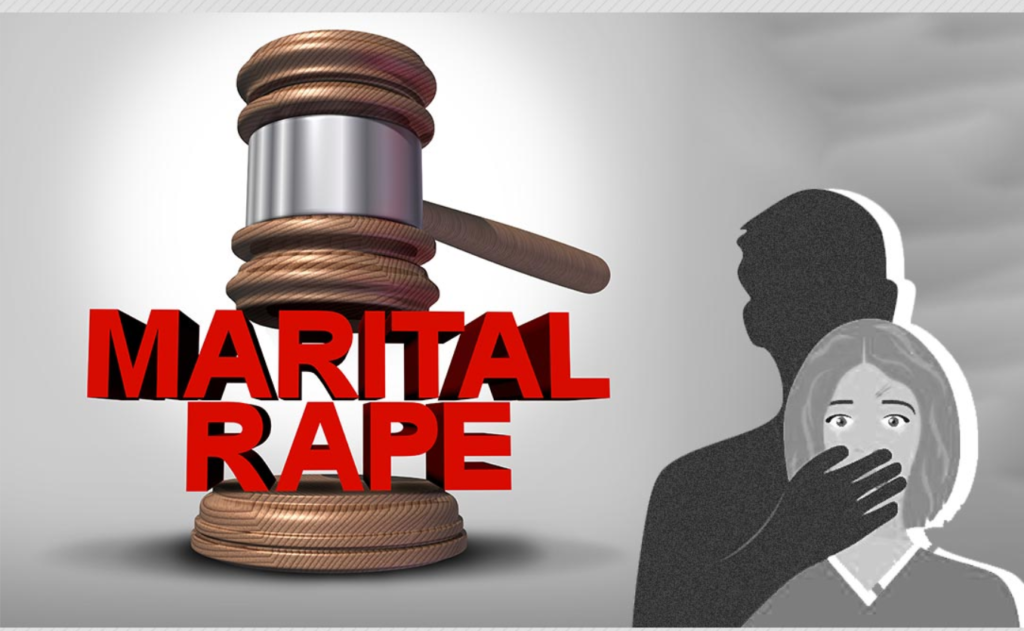On February 21 2022, the Delhi High Court reserved its judgement on a batch of petitions challenging the exception II of Section 375 of the Indian Penal Code which exempts marital rape from criminalization. Marital rape refers to the rape when the perpetrator is the victim’s spouse. The focus of this argument is on consent for having a sexual intercourse in a spousal relationship.

According to the union government, the subject of criminalization needs a comprehensive approach rather than a strictly legal approach. As per the affidavit submitted by the government to the Delhi High Court:
“As already pointed out on earlier occasions, the provisions of Section 375 and the socio-legal implications of grant of prayer need an exercise of a meaningful consultative process with various stakeholders on several aspects”.
Advocate Karuna Nundy, the counsel appearing for the petitioners, raised the argument that marital rape exception takes away a married woman’s ability to say a ‘joyful yes’ to sexual intercourse, adding that her sexual desire and consent is reduced to a nullity. The amicus curiae for the case, Senior Advocate Rebecca John, concluded in her submissions that it is not constitutional. Appearing as the other amicus curiae, Senior Advocate, Rajshekhar Rao, has put that while the legislature does not say that the husband is entitled to sexually assault or abuse his wife, the marital rape exception suggests that a man can rape his wife and get away from the prosecution of rape.
An interesting observation that can be made from all these pattern of events is that when we take this law into account, two aspects need to be highlighted; the first being marital rape question not only surrounds two spousal individuals but also the society where they live in and secondly, a private relationship between them is the center of the argument.
It can be roughly inferred that the contemporary stakeholders about which the UOI’s counsel argues are two; the first being society at large and the second being spousal individuals themselves. If marital rape exception is removed, an important question arises- Which generation individuals would be affected the most ?
Generation Z belongs to the people who were born between the years 1997-2012. Ostensibly, these are the people who would get married or are getting married in the coming years and are the individuals who would be affected the most by altered laws penetrating a marital relationship.
Harry Beard, an entrepreneur who co-founded the generation Z marketing consultancy firm “Future Labs”, mentions in his Ted talk that “we are programmed so differently to any past generation,” “We’ve been developing a brand from the minute we join social media. The new world has been moulding us into these mini trail blazers that we do not even realise”. The few characteristics that differentiate the Generation Z from other generations as mentioned in an Oxford Royale Academy article are :
They are digital natives, the world they live in has never felt safe, they are changing the distinction between childhood and adulthood, and they value their privacy more than any other generation.
This generation has changed the perspective of spousal relationship, intimacy and consent. It is believed to be the most well-read generation with a power to drive masses with a post or a tweet. According to census India 2011, almost 58.1% of India’s population is between the age group of 11- 44, roughly belonging to this Generation Z. This gives a rough idea about the young population in India. As such, a law regulating their individual relationships needs to take into account their perspective on relationships.

The history of criminalization of marital rape
Poland, in the year 1932, was the first country to declare marital rape as a criminal offence. In the 1970s to 1990s, a majority of common law countries like Australia, Ghana, Malaysia, New Zealand, etc. had legislatively removed the exception of marital rape or had explicitly criminalized marital rape.
Most nations criminalized marital rape only after the UN’s “Declaration on the Elimination of Violence Against Women” in 1993. Hence, marital rape is a crime which might have existed in ancient times as well but was not given recognition. This change came with the changing dynamics of spousal relationship and position of women in society crediting it to the waves of feminism.
To criminalise or not to criminalise?
There are three broad arguments that are given in defence of not criminalizing marital rape.
According to a research paper by Raveena Rao Kallakuru & Pradyumna Soni in the NUJS law review 2018, three broad reasons for aversion towards the criminalization of marital rape have been formulated after going through the reasonings given by the various law commission reports and Government of India.
The first reason is protection of the institution of marriage. With the change in dynamics of relationships and arrival of live-in relationships and same sex marriages, the institution of marriage is changing the current generation.
Jessica Klein writes for the BBC, “An increasing body of research validates this opinion: members of Gen Z seem to take an especially pragmatic approach to relationships compared to prior generations ”.
In addition to this, the Supreme Court stated in Independent Thought v. Union of India that criminalising marital rape would not destroy the institution of marriage if divorce and judicial separation cannot. The Gujarat High Court stated in Nimeshbhai Bharatbhai Desai v. State of Gujarat (2018) that marital rape breaches the trust and confidence inside the marriage and harms the institution of marriage.
The second reason deals with the alternative remedies and other resources that already exist for a woman to seek recourse through ( 498A of the IPC, PWDVA 2005) personal laws. In absence of a specific law, victims have to go through rigorous procedural aspects of laws denying them justice. With changing times of interpretation, the exception needs to be removed first.
The third is focused upon the cultural values in India. The cultural values of India cannot fit in some rigid boundaries, they are dynamic and integrated with changing dimension and inclusive character. Moreover, no culture teaches to disrespect women and deny them basic rights. The outdated law of marital rape does not fit in the ‘culture’ of current generation as the generation talks and works on the ideals of equality and justice, not only for women but of gender.
As such, marital rape criminalization and removal of the exception II of Section 375 of the Indian Penal Code is need of the hour. If a socially prevalent misdeed is not inhibited by the government of the nation, the government is guilty of failing its citizens.
A first year law student at Dr. B.R. Ambedkar National Law University, Haryana. Intrested in human rights, caste and tribes.



An interesting discussion is worth comment. I think that you should write more on this topic, it might not be a taboo subject but generally people are not enough to speak on such topics. To the next. Cheers
Good info. Lucky me I reach on your website by accident, I bookmarked it.
Definitely imagine that that you stated. Your favourite reason seemed to be at the internet the easiest factor to take into accout of. I say to you, I certainly get irked at the same time as people consider concerns that they just don’t understand about. You controlled to hit the nail upon the top and also outlined out the whole thing without having side-effects , people could take a signal. Will likely be back to get more. Thank you
Hi, i think that i saw you visited my weblog so i came to “return the favor”.I am trying to find things to enhance my website!I suppose its ok to use some of your ideas!!